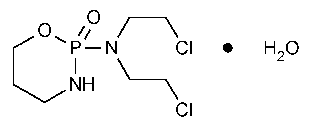Cyclophosphamide
2H-1,3,2-Oxazaphosphorin-2-amine,N,N-bis(2-chloroethyl)tetrahydro-,2-oxide,monohydrate,(±).
(±)-2-[Bis(2-chloroethyl)amino]tetrahydro-2H-1,3,2-oxazaphosphorine 2-oxide monohydrate [6055-19-2].
Anhydrous 261.09 [50-18-0].
»Cyclophosphamide contains not less than 97.0percent and not more than 103.0percent of C7H15Cl2N2O2P,calculated on the anhydrous basis.
Caution—Great care should be taken in handling Cyclophosphamide,as it is a potent cytotoxic agent.
Packaging and storage—
Preserve in tight containers,at a temperature between 2 and 30
and 30 .
.
Identification—
A:
Infrared Absorption á197Kñ.
B:
The retention time of the major peak in the chromatogram of the Assay preparationcorresponds to that of the Standard preparation,both relative to the internal standard,as obtained in the Assay.
pHá791ñ:
between 3.9and 7.1,in a solution (1in 100),determined 30minutes after its preparation.
Water,Method Iá921ñ:
between 5.7%and 6.8%.
Heavy metals á231ñ—
Dissolve 1.0g in 25mLof water,and filter if necessary:the limit is 0.002%.
Assay—
Mobile phase—
Prepare a suitable,degassed solution of water and acetonitrile (70:30).
Internal standard solution—
Dissolve about 185mg of ethylparaben in 250mLof alcohol in a 1000-mLvolumetric flask,dilute with water to volume,and mix.
Standard preparation—
Transfer an accurately weighed quantity of USP Cyclophosphamide RS,equivalent to about 25mg of anhydrous cyclophosphamide,to a 50-mLvolumetric flask,add about 25mLof water,and shake to dissolve the USP Reference Standard.Add 5.0mLof Internal standard solution,dilute with water to volume,and mix to obtain a Standard preparationhaving a known concentration of about 0.5mg of anhydrous cyclophosphamide per mL.
Assay preparation—
Transfer an accurately weighed quantity of Cyclophosphamide,equivalent to about 200mg of anhydrous cyclophosphamide,to a 200-mLvolumetric flask,add about 50mLof water,shake for about 5minutes,dilute with water to volume,and mix.Pipet 25mLof this solution and 5mLof Internal standard solutioninto a 50-mLvolumetric flask,dilute with water to volume,and mix.
Chromatographic system
(see Chromatography á621ñ)—The liquid chromatograph is equipped with a 195-nm detector and a 3.9-mm ×30-cm column that contains packing L1.The flow rate is about 1.5mLper minute.Chromatograph six replicate injections of the Standard preparation,and record the peak responses as directed for Procedure:the relative standard deviation is not more than 2%,and the resolution factor between cyclophosphamide and ethylparaben is not less than 2.
Procedure—
Separately inject equal volumes (about 25µL)of the Standard preparationand the Assay preparationinto the chromatograph,record the chromatograms,and measure the responses for the major peaks.The relative retention times are about 0.7for cyclophosphamide and 1.0for ethylparaben.Calculate the quantity,in mg,of C7H15Cl2N2O2Pin the Cyclophosphamide taken by the formula:
400C(RU/RS),
in which Cis the concentration,in mg per mL,of anhydrous cyclophosphamide in the Standard preparation,as determined from the concentration of USP Cyclophosphamide RScorrected for moisture content by a titrimetric water determination;and RUand RSare the ratios of the peak responses of cyclophosphamide to those of ethylparaben in the Assay preparationand the Standard preparation,respectively.
Auxiliary Information—
Staff Liaison:Lawrence Evans,III,Ph.D.,Scientist
Expert Committee:(PA6)Pharmaceutical Analysis 6
USP28–NF23Page 558
Phone Number:1-301-816-8389
